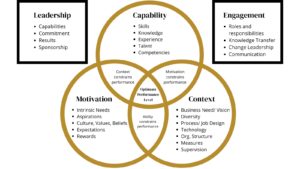by Donald Barnhart
Business books and blogs today are filled with facts and theories about the unprecedented era of disruption. Businesses have been disrupted… remember the world before Apple, Napster, Google, Amazon, and Tesla? Employees have also been disrupted by the current business climate, the global pandemic, and recuperating from the “Great Resignation” of 2021, which impacted their daily lives.
Businesses must consider strategically how to transform to compete and win in today’s economy, and organizational change management (OCM) practitioners must change their practices to keep in step with the times. So how do you go about organizational change management today?
Once leaders have identified the performance levers to use in support of the change, it’s time to begin planning the change implementation with the appropriate change management focus. This requires Driving Change in the Center and Enabling Change Emergently.

NCE leaders have identified the performance levers to use in support of the change. It’s time to begin planning the change implementation with the appropriate change management focus.
Drive Change In The Center
Driving change in the center is about driving change in the middle of the organization, the key to performance and change success. In business, change starts at the top and happens at the bottom.
- The middle of the organization is responsible for ensuring strategic alignment in the organization anddriving performance on the front lines.
- Failure in the middle means organizational strategies aren’t achieved and change isn’t adopted or sustained.
Every organization’s middle management is a key to change success. While this is often desired and discussed when implementing strategic change, it’s seldom realized. Organizations are often left with workers who don’t want to change and don’t care. To be successful in the center, middle managers will need:
- Clear expectations for their roles and responsibilities.
- Leaders who support their role and hold them accountable.
- And a clear understanding of:
- The reality of the change, including the facts and uncomfortable truths.
- Change process for individuals, including the requirement and techniques to address the rational and emotional side of change.
- A detailed path forward for their group and the organization.
And then, the center of the organization will need to enable that change emergently.
Enabling Change Emergently
The third key factor in successful OCM today is enabling change when the need emerges.
Traditionally, Conner’s Commitment Curve shows that installation of the change (or system) is at the center of the change curve for individuals. Yet most change initiatives front load change activities before the installation or “go-live.” Given today’s overloaded employees and change-taxed organizations, the peak of change activities needs to be shifted until after the installation to serve the employees at the point of need, when the need emerges. This moves the change activities to a time where employees have the time, attention, and energy to make the change.
As technology continues to change the way we work, transformations will require changes to the way we prepare the workforce. Instead of long training programs and mountains of documentation before the installation, the construction and delivery of communications, training, and support must adapt to be available at the point of need. New tools and techniques help enable this like digital adoption platforms (DAP) with context-specific support and “drip” training methods.
The world and the business environment in which we compete have changed dramatically in the last decade. Whether you’re changing to meet the current market or chart a new path to the future, you can drive better results through change management plans that:
- Address change holistically recognizing the change burdens already present in your organization and its employees.
- Drive change in the center putting accountability where it drives the best results.
- Enable change emergently where employees have the energy and attention at the point of need.
If your change management activities are stuck with the same tools and techniques from the last 5-10 years, contact Opportune for a fresh perspective to drive performance results through change management strategies that bring about lasting change in the age of disruption.
About The Expert
Donald Barnhart is a Director in Opportune LLP’s Process and Technology practice based in Houston. Barnhart has over 25 years of experience in change management consulting in the energy industry with Opportune, 2Develop, and Accenture, with a focus on energy trading and risk management. Barnhart has worked with integrated supermajors, midstream companies, and independent trading firms. All his change projects drive organization performance improvement, implement strategic initiatives, and foster cultural change. He holds an M.A. in Instructional Systems Design from the University of Maryland, Baltimore County, and a B.S. in Elementary Education from the University of Delaware.










